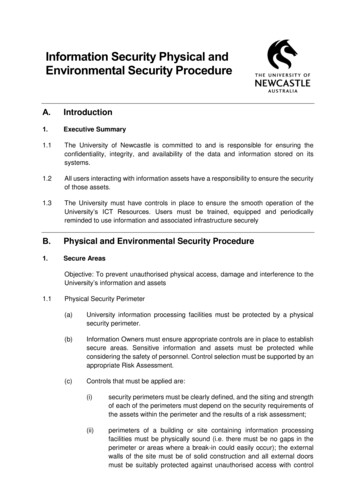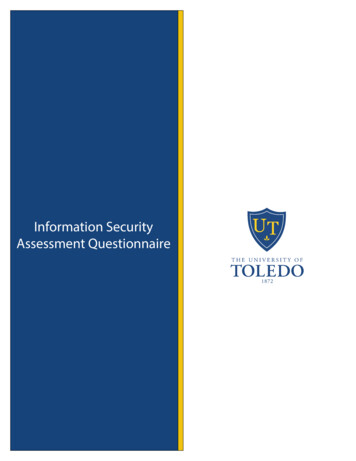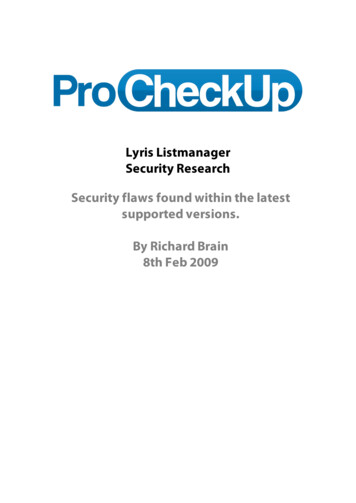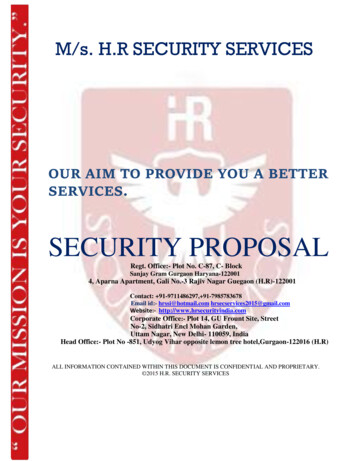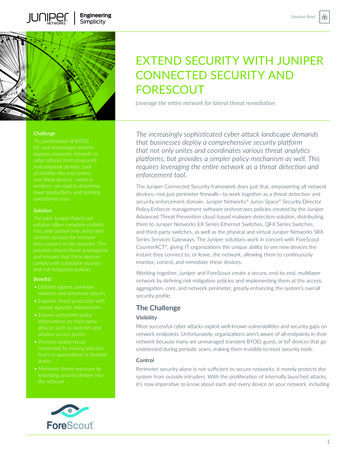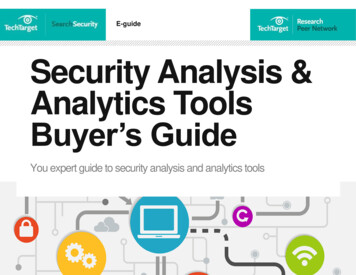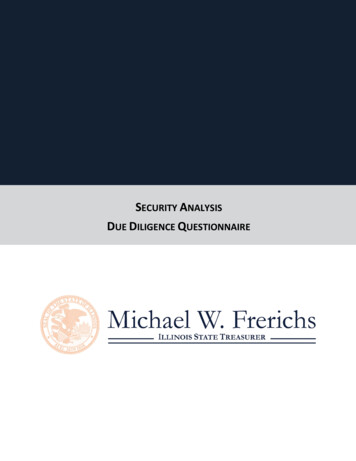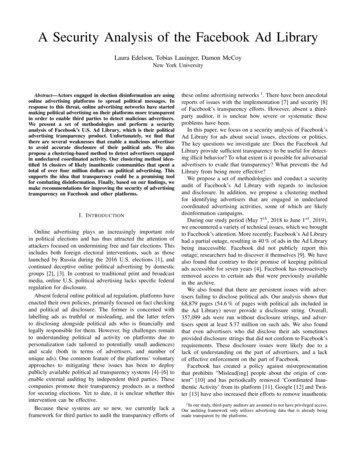
Transcription
A Security Analysis of the Facebook Ad LibraryLaura Edelson, Tobias Lauinger, Damon McCoyNew York UniversityAbstract—Actors engaged in election disinformation are usingonline advertising platforms to spread political messages. Inresponse to this threat, online advertising networks have startedmaking political advertising on their platforms more transparentin order to enable third parties to detect malicious advertisers.We present a set of methodologies and perform a securityanalysis of Facebook’s U.S. Ad Library, which is their politicaladvertising transparency product. Unfortunately, we find thatthere are several weaknesses that enable a malicious advertiserto avoid accurate disclosure of their political ads. We alsopropose a clustering-based method to detect advertisers engagedin undeclared coordinated activity. Our clustering method identified 16 clusters of likely inauthentic communities that spent atotal of over four million dollars on political advertising. Thissupports the idea that transparency could be a promising toolfor combating disinformation. Finally, based on our findings, wemake recommendations for improving the security of advertisingtransparency on Facebook and other platforms.I. I NTRODUCTIONOnline advertising plays an increasingly important rolein political elections and has thus attracted the attention ofattackers focused on undermining free and fair elections. Thisincludes both foreign electoral interventions, such as thoselaunched by Russia during the 2016 U.S. elections [1], andcontinued deceptive online political advertising by domesticgroups [2], [3]. In contrast to traditional print and broadcastmedia, online U.S. political advertising lacks specific federalregulation for disclosure.Absent federal online political ad regulation, platforms haveenacted their own policies, primarily focused on fact checkingand political ad disclosure. The former is concerned withlabelling ads as truthful or misleading, and the latter refersto disclosing alongside political ads who is financially andlegally responsible for them. However, big challenges remainto understanding political ad activity on platforms due topersonalization (ads tailored to potentially small audiences)and scale (both in terms of advertisers, and number ofunique ads). One common feature of the platforms’ voluntaryapproaches to mitigating these issues has been to deploypublicly available political ad transparency systems [4]–[6] toenable external auditing by independent third parties. Thesecompanies promote their transparency products as a methodfor securing elections. Yet to date, it is unclear whether thisintervention can be effective.Because these systems are so new, we currently lack aframework for third parties to audit the transparency efforts ofthese online advertising networks 1 . There have been anecdotalreports of issues with the implementation [7] and security [8]of Facebook’s transparency efforts. However, absent a thirdparty auditor, it is unclear how severe or systematic theseproblems have been.In this paper, we focus on a security analysis of Facebook’sAd Library for ads about social issues, elections or politics.The key questions we investigate are: Does the Facebook AdLibrary provide sufficient transparency to be useful for detecting illicit behavior? To what extent is it possible for adversarialadvertisers to evade that transparency? What prevents the AdLibrary from being more effective?We propose a set of methodologies and conduct a securityaudit of Facebook’s Ad Library with regards to inclusionand disclosure. In addition, we propose a clustering methodfor identifying advertisers that are engaged in undeclaredcoordinated advertising activities, some of which are likelydisinformation campaigns.During our study period (May 7th , 2018 to June 1st , 2019),we encountered a variety of technical issues, which we broughtto Facebook’s attention. More recently, Facebook’s Ad Libraryhad a partial outage, resulting in 40 % of ads in the Ad Librarybeing inaccessible. Facebook did not publicly report thisoutage; researchers had to discover it themselves [9]. We havealso found that contrary to their promise of keeping politicalads accessible for seven years [4], Facebook has retroactivelyremoved access to certain ads that were previously availablein the archive.We also found that there are persistent issues with advertisers failing to disclose political ads. Our analysis shows that68,879 pages (54.6 % of pages with political ads included inthe Ad Library) never provide a disclosure string. Overall,357,099 ads were run without disclosure strings, and advertisers spent at least 37 million on such ads. We also foundthat even advertisers who did disclose their ads sometimesprovided disclosure strings that did not conform to Facebook’srequirements. These disclosure issues were likely due to alack of understanding on the part of advertisers, and a lackof effective enforcement on the part of Facebook.Facebook has created a policy against misrepresentationthat prohibits “Mislead[ing] people about the origin of content” [10] and has periodically removed ‘Coordinated Inauthentic Activity’ from its platform [11]. Google [12] and Twitter [13] have also increased their efforts to remove inauthentic1 In our study, third-party auditors are assumed to not have privileged access.Our auditing framework only utilizes advertising data that is already beingmade transparent by the platforms.
content from their platforms. We applaud these policies and theimprovements in their enforcement by the platforms. However,approaches about which ads they include in their archive, andhow much metadata they make available. In the remainderof this paper, we focus on Facebook’s approach, as it is thelargest both in size and scope. We also restrict our analysis tothe U.S. market.A. FacebookFig. 1: Inauthentic Communitiesour clustering method, and manual analysis of these clusters,still find numerous likely inauthentic groups buying similarads in a coordinated way. Specifically, we found 16 clustersof likely inauthentic communities that spent 3,867,613 ona total of 19,526 ads. The average lifespan of these clusterswas 210 days, demonstrating that Facebook is not effectivelyenforcing their policy against misrepresentation. Figure 1shows an example of undeclared coordination among a groupof likely inauthentic communities all paying for the samepolitical ads.We will make publicly available all of our analysis code,and we will also make our ad data available to organizationsapproved to access Facebook’s Ad Library API 2 .In summary, our main contributions are as follows: We present an algorithm for discovering advertisers engaging in potentially undeclared coordinated activity. Wethen use our method to find advertisers likely violatingFacebook’s policies. This demonstrates that transparencyas a mechanism for improving security can potentially beeffective. We show that Facebook’s Ad Library, as currently implemented, has both design and implementation flaws thatdegrade that transparency. We make recommendations for improving the security ofpolitical advertising transparency on Facebook and otherplatforms.II. BACKGROUNDA key feature of advertising on social media platformsis fine-grained targeting based on users’ demographic andbehavioral characteristics. This allows advertisers to createcustom-tailored messaging for narrow audiences. As a result,different users typically see different ads, and it is challengingfor outsiders to expose unethical or illegal advertising activity.In an effort to provide more transparency in the politicaladvertising space, several social media platforms have createdpublic archives of ads that are deemed political. Due to a lackof official regulation, different platforms have taken different2 The data is publicly available to anyone through Facebook’s website butFacebook restricts API access to vetted Facebook accounts.Ads in Facebook resemble posts in the sense that in additionto the text, image, or video, they always contain the nameand picture of a Facebook page as their “author.” In practice,advertisers do not necessarily create their own pages to runads. Instead, they may hire social media influencers to runads on their behalf; these ads appear as if “authored” by theinfluencer’s page. In the remainder of this paper, we referto the entity that pays for the ad as the advertiser, and theFacebook page running the ad as the ad’s sponsor. If anad’s advertiser and sponsor are different, the advertiser doesnot interact with Facebook; the sponsor creates the ad inthe system and is responsible for complying with Facebook’spolicies.1) Scope: Facebook has relatively broad criteria for makingads transparent, including not only ads about political candidates at any level of public office, but also ads about socialissues. In detail, Facebook includes any ad that “(1) Is madeby, on behalf of, or about a current or former candidate forpublic office, a political party, a political action committee, oradvocates for the outcome of an election to public office; (2) Isabout any election, referendum, or ballot initiative, including‘get out the vote’ or election information campaigns; (3) Isabout social issues in any place where the ad is being run; (4)Is regulated as political advertising.” [14] Relevant social issues include Abortion, Budget, Civil Rights, Crime, Economy,Education, Energy, Environment, Foreign Policy, GovernmentReform, Guns, Health, Immigration, Infrastructure, Military,Poverty, Social Security, Taxes, Terrorism, and Values [15].2) Policies & Enforcement: In the political space, Facebookaims to provide some transparency by requiring ad sponsorsto declare each individual ad as political, and disclose theidentity of the advertiser who paid for it. Many details ofFacebook’s policies changed over the course of our research,often without public announcement, and sometimes retroactively. For instance, Facebook retroactively introduced a graceperiod before enforcing the requirement that political ads bedeclared, and retroactively exempted ads run by news outlets.Here, we give a broad overview of the policies in effect at thetime the ads in our dataset were created.Before ad sponsors can declare that an ad is political, theymust undergo a vetting process, which includes identity verification. As part of this process, they also create “disclaimers,”which we call disclosure strings. During the time periodcovered by our dataset, disclosure strings were free-form textfields with the requirement that they “accurately represent thename of the entity or person responsible for the ad,” and “notinclude URLs or acronyms, unless they make up the completeofficial name of the organization” [16]. Once the vettingprocess has completed, for each new ad that they create, ad
sponsors can (and must) declare whether it is political byselecting a checkbox. As a consequence of declaring an adas political, the ad will be archived in Facebook’s public AdLibrary for seven years [4]. Furthermore, the disclosure stringwill be displayed with the ad when it is shown to users onFacebook or Instagram.To a large extent, Facebook relies on the cooperation of adsponsors to comply proactively with this policy. Only vettedaccounts can declare an ad as political, and even then, adsponsors must “opt in” each individual ad. According to ourunderstanding, Facebook uses a machine learning approachto detect political ads that their sponsors failed to declare.Undeclared ads detected prior to the start of the campaignare terminated, and not included in the Ad Library. Onceads are active, users can report them as not complying withdisclosure requirements. Furthermore, Facebook appears toconduct additional, potentially manual, ad vetting dependingon the ad’s reach, i.e., for ads with high impression counts.Undeclared political ads that are caught after they have alreadybeen shown to users are terminated, and added to the AdLibrary with an empty disclosure string. According to privateconversations with Facebook, enforcement was done at anindividual ad level. As a result, there appeared to be littleto no consequences for similar undisclosed ads, or for repeatoffenders.3) Implementation: Facebook operates a general Ad Library, which contains all ads that are currently active onFacebook and Instagram [4]. At the time of writing, thewebsite is freely accessible and contains ad media such asthe text, image or video. However, access through automatedprocesses such as web crawlers is disallowed. For politicalads only, the library also includes historical data. The websitenotes that political ads are to be archived for seven years,starting with data from May 2018.The political ads in the library are accessible through anAPI [17]. For each ad, the API contains a unique ID, impression counts and the dollar amount spent on the ad, as well asthe dates when the ad campaign started and ended. Facebookreleases ad impression and spend data in imprecise ranges,such as 0 – 100 spend, or 1,000 – 5,000 impressions. Atthe time of our study, some data available through the webportal were not accessible through the API. Specifically, adimages and videos were not programmatically accessible.In addition to the ad library, Facebook also publishes a dailyAd Library Report [18] containing all pages that sponsoredpolitical ads, as well as the disclosure strings used, and theexact dollar amount spent (if above 100). At the end of ourstudy period, 126 k Facebook pages had sponsored at least onepolitical ad.III. R ELATED W ORKA. Online Ad TransparencyPrior work has proposed methods for independently collecting and analyzing data about online ad networks. Guhaet al. [19] proposed a set of statistical methodologies forimproving online advertising transparency. Barford et al. [20]deployed Adscape, a crawler-based method of collecting andanalyzing online display ads independent of the ad network.Lécuyer et al. [21] proposed a statistical method for inferringcustomization of websites including targeted ads. The Sunlightsystem was able to infer some segment and demographic targeting information of online ads using statistical methods [22].All of this prior work was limited by the small amount of datathese systems could independently collect, and the inherentnoise of attempting to infer information from likely biaseddata.More recently, Facebook has deployed an ad targetingtransparency feature, which provides a partial explanation tousers why they are seeing a certain ad. Andreou et al. [23]investigated the limitations and usefulness of this explanation.In a separate work, Andreou et al. [24] built a browser pluginthat collected crowdsourced ad and targeting information, andperformed an analysis of the advertisers using Facebook’sad network. This prior work focuses on understanding transparency around ad targeting.Closest to our work is a pair of studies analyzing politicaladvertisers using data from Facebook’s Ad Library and ProPublica’s browser plugin. Ghosh et al. [25] demonstrated thatlarger political advertisers frequently use lists of PersonallyIdentifiable Information (PII) for targeting. Edelson at al. [26]mentioned the existence of problematic political for-profitmedia and corporate astroturfing advertisers. However, ourstudy is, to the best of our knowledge, the first to propose anauditing framework for online ad transparency portals and usethis framework to conduct a security analysis of Facebook’sAd Library.B. Disinformation/Information WarfareThere is a growing amount of prior work reviewing recent Russian attempts to interfere in the democratic elections of other countries via information attacks. Farrelland Schneier [27] examine disinformation as a commonknowledge attack against western-style democracies. Caufieldet al. [28] review recent attacks in the United States and UnitedKingdom as well as potential interventions through the lensof usable security. Starbird et al. [29] present case studies ofdisinformation campaigns on Twitter and detail many of thekey features that such disinformation campaigns share. Oneinsight is that inauthentic communities are often created aspart of disinformation attacks. This is a key part in the designof our algorithm for detecting likely undisclosed coordinatedadvertising.C. Clustering Based Abuse Detection MethodsThere is a wealth of prior work exploring how to detectspam and other abuse by using content analysis and clusteringmethods. There are many studies which have proposed textsimilarity methods and clustering to detect email ( [30], [31]),Online Social Networking (OSN) ( [32], [33]), SMS [34],and website spam [35], and other types of abusive activities.Our method of detecting undisclosed coordinated activitybetween political advertisers is largely based on this prior
work. In the space of political advertising, Kim et al. [36]manually annotated ads with topics and advertisers for thepurpose of grouping and analysis. In contrast, our clusteringmethod is automated except for manual validation of parameterthresholds.Total AdsPagesDisclosuresTotal Spend3,685,558122,14158,494 623,697,453 – 628,461,938TABLE I: Political ad dataset extracted using the API (studyperiod from May 24th , 2018 to June 1st , 2019).IV. M ETHODOLOGY F RAMEWORKThe goal of this paper is twofold. First, we aim to provide aframework of methodologies for auditing the tools introducedby social media platforms to improve transparency aroundadvertising of political and societal topics. From a securitypoint of view, issues of interest are how the platform’s implementation of transparency affects ad sponsors’ compliancewith transparency policies, how the platform handles noncompliance, and whether the available data is rich enough todetect advertising behavior that likely violates the platform’spolicies. Based on the transparency tools currently available,this concretely involves retrieving the complete archive of adsdeemed political, verifying the consistency of the archive,auditing the disclosures of who paid for ads, and detectingundesirable advertising behavior in the archive, especially withrespect to potential violations of platform policies. In additionto proposing this methodology framework, as the second goalof this paper, we apply this methodology to conduct a securityanalysis of Facebook’s Ad Library. We selected Facebookbecause to date it is the largest archive, both in scale andscope.Limitations: Ideally, efforts to audit transparency toolsshould also assess the completeness of the ad archive, i.e.,how many (undetected) political ads on the platform areincorrectly missing in the archive. For platforms that ban political advertising, an important question is whether the ban isenforced effectively. Another key issue is whether disclosuresare accurate, i.e., whether they identify the true source offunding. Unfortunately, answering these important questionsis difficult, or impossible with the data made available by thesocial media platforms at the time of our study. As we haveto operate within the constraints of the available data, we canonly provide limited insight into these aspects at this time. Weleave a more comprehensive study of archive completeness anddisclosure accuracy for future work. Similarly, we focus ourcurrent efforts on metadata analysis, and plan to investigatead contents, such as topics, messaging, and customization, inmore detail in future work.A. Data CollectionAs a prerequisite for all subsequent analysis, we need toretrieve all ad data available in the transparency archive. Inthe case of Facebook’s Ad Library, at the time of our study,API access to ads was only provided through keyword search,or using the identifier of the sponsoring page. Therefore,we proceed in two steps. As the first step, we collect acomprehensive list of Facebook pages running political ads.We obtain this list from the Ad Library Report [18] publishedby Facebook. We download this report once
reports of issues with the implementation [7] and security [8] of Facebook’s transparency efforts. However, absent a third-party auditor, it is unclear how severe or systematic these problems have been. In this paper, we focus on a security analysis of Facebook’s Ad Li
